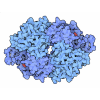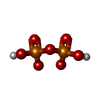[English] 日本語
 Yorodumi
Yorodumi- PDB-3p7z: Crystal structure of the Neurofibromin Sec14-PH module containing... -
+ Open data
Open data
- Basic information
Basic information
| Entry | Database: PDB / ID: 3p7z | ||||||
|---|---|---|---|---|---|---|---|
| Title | Crystal structure of the Neurofibromin Sec14-PH module containing the patient derived mutation I1584V | ||||||
 Components Components | Neurofibromin | ||||||
 Keywords Keywords | LIPID BINDING PROTEIN / Sec14 homolgy domain /  pleckstrin homology domain / binding of glycerophospholipids / glycerophospholipids / cytoplasmatic pleckstrin homology domain / binding of glycerophospholipids / glycerophospholipids / cytoplasmatic | ||||||
| Function / homology |  Function and homology information Function and homology informationpositive regulation of mast cell apoptotic process / negative regulation of Rac protein signal transduction / regulation of glial cell differentiation / gamma-aminobutyric acid secretion, neurotransmission /  observational learning / Schwann cell migration / negative regulation of Schwann cell migration / vascular associated smooth muscle cell migration / amygdala development / mast cell apoptotic process ...positive regulation of mast cell apoptotic process / negative regulation of Rac protein signal transduction / regulation of glial cell differentiation / gamma-aminobutyric acid secretion, neurotransmission / observational learning / Schwann cell migration / negative regulation of Schwann cell migration / vascular associated smooth muscle cell migration / amygdala development / mast cell apoptotic process ...positive regulation of mast cell apoptotic process / negative regulation of Rac protein signal transduction / regulation of glial cell differentiation / gamma-aminobutyric acid secretion, neurotransmission /  observational learning / Schwann cell migration / negative regulation of Schwann cell migration / vascular associated smooth muscle cell migration / amygdala development / mast cell apoptotic process / negative regulation of mast cell proliferation / Schwann cell proliferation / vascular associated smooth muscle cell proliferation / mast cell proliferation / glutamate secretion, neurotransmission / negative regulation of Schwann cell proliferation / negative regulation of leukocyte migration / negative regulation of vascular associated smooth muscle cell migration / positive regulation of adenylate cyclase activity / regulation of cell-matrix adhesion / forebrain morphogenesis / negative regulation of neurotransmitter secretion / hair follicle maturation / observational learning / Schwann cell migration / negative regulation of Schwann cell migration / vascular associated smooth muscle cell migration / amygdala development / mast cell apoptotic process / negative regulation of mast cell proliferation / Schwann cell proliferation / vascular associated smooth muscle cell proliferation / mast cell proliferation / glutamate secretion, neurotransmission / negative regulation of Schwann cell proliferation / negative regulation of leukocyte migration / negative regulation of vascular associated smooth muscle cell migration / positive regulation of adenylate cyclase activity / regulation of cell-matrix adhesion / forebrain morphogenesis / negative regulation of neurotransmitter secretion / hair follicle maturation /  cell communication / regulation of blood vessel endothelial cell migration / camera-type eye morphogenesis / smooth muscle tissue development / negative regulation of oligodendrocyte differentiation / cell communication / regulation of blood vessel endothelial cell migration / camera-type eye morphogenesis / smooth muscle tissue development / negative regulation of oligodendrocyte differentiation /  sympathetic nervous system development / sympathetic nervous system development /  myelination in peripheral nervous system / myeloid leukocyte migration / myelination in peripheral nervous system / myeloid leukocyte migration /  phosphatidylcholine binding / phosphatidylcholine binding /  peripheral nervous system development / peripheral nervous system development /  phosphatidylethanolamine binding / metanephros development / positive regulation of extrinsic apoptotic signaling pathway in absence of ligand / negative regulation of Ras protein signal transduction / collagen fibril organization / phosphatidylethanolamine binding / metanephros development / positive regulation of extrinsic apoptotic signaling pathway in absence of ligand / negative regulation of Ras protein signal transduction / collagen fibril organization /  regulation of bone resorption / regulation of long-term synaptic potentiation / neural tube development / endothelial cell proliferation / forebrain astrocyte development / regulation of bone resorption / regulation of long-term synaptic potentiation / neural tube development / endothelial cell proliferation / forebrain astrocyte development /  pigmentation / artery morphogenesis / regulation of postsynapse organization / pigmentation / artery morphogenesis / regulation of postsynapse organization /  regulation of synaptic transmission, GABAergic / negative regulation of neuroblast proliferation / negative regulation of MAPK cascade / adrenal gland development / negative regulation of protein import into nucleus / negative regulation of cell-matrix adhesion / spinal cord development / regulation of synaptic transmission, GABAergic / negative regulation of neuroblast proliferation / negative regulation of MAPK cascade / adrenal gland development / negative regulation of protein import into nucleus / negative regulation of cell-matrix adhesion / spinal cord development /  regulation of GTPase activity / Rac protein signal transduction / oligodendrocyte differentiation / negative regulation of osteoclast differentiation / negative regulation of endothelial cell proliferation / RAS signaling downstream of NF1 loss-of-function variants / negative regulation of astrocyte differentiation / extrinsic apoptotic signaling pathway via death domain receptors / neuroblast proliferation / regulation of GTPase activity / Rac protein signal transduction / oligodendrocyte differentiation / negative regulation of osteoclast differentiation / negative regulation of endothelial cell proliferation / RAS signaling downstream of NF1 loss-of-function variants / negative regulation of astrocyte differentiation / extrinsic apoptotic signaling pathway via death domain receptors / neuroblast proliferation /  regulation of angiogenesis / Schwann cell development / negative regulation of stem cell proliferation / negative regulation of fibroblast proliferation / skeletal muscle tissue development / extrinsic apoptotic signaling pathway in absence of ligand / positive regulation of vascular associated smooth muscle cell proliferation / positive regulation of endothelial cell proliferation / extracellular matrix organization / negative regulation of angiogenesis / regulation of angiogenesis / Schwann cell development / negative regulation of stem cell proliferation / negative regulation of fibroblast proliferation / skeletal muscle tissue development / extrinsic apoptotic signaling pathway in absence of ligand / positive regulation of vascular associated smooth muscle cell proliferation / positive regulation of endothelial cell proliferation / extracellular matrix organization / negative regulation of angiogenesis /  GTPase activator activity / negative regulation of cell migration / osteoclast differentiation / regulation of ERK1 and ERK2 cascade / phosphatidylinositol 3-kinase/protein kinase B signal transduction / liver development / negative regulation of MAP kinase activity / stem cell proliferation / long-term synaptic potentiation / regulation of long-term neuronal synaptic plasticity / negative regulation of protein kinase activity / GTPase activator activity / negative regulation of cell migration / osteoclast differentiation / regulation of ERK1 and ERK2 cascade / phosphatidylinositol 3-kinase/protein kinase B signal transduction / liver development / negative regulation of MAP kinase activity / stem cell proliferation / long-term synaptic potentiation / regulation of long-term neuronal synaptic plasticity / negative regulation of protein kinase activity /  wound healing / wound healing /  brain development / brain development /  visual learning / cerebral cortex development / visual learning / cerebral cortex development /  cognition / positive regulation of GTPase activity / osteoblast differentiation / Regulation of RAS by GAPs / protein import into nucleus / cognition / positive regulation of GTPase activity / osteoblast differentiation / Regulation of RAS by GAPs / protein import into nucleus /  MAPK cascade / positive regulation of neuron apoptotic process / presynapse / MAPK cascade / positive regulation of neuron apoptotic process / presynapse /  heart development / cellular response to heat / fibroblast proliferation / actin cytoskeleton organization / heart development / cellular response to heat / fibroblast proliferation / actin cytoskeleton organization /  regulation of gene expression regulation of gene expressionSimilarity search - Function | ||||||
| Biological species |   Homo sapiens (human) Homo sapiens (human) | ||||||
| Method |  X-RAY DIFFRACTION / X-RAY DIFFRACTION /  SYNCHROTRON / SYNCHROTRON /  MOLECULAR REPLACEMENT / Resolution: 2.65 Å MOLECULAR REPLACEMENT / Resolution: 2.65 Å | ||||||
 Authors Authors | Welti, S. / Scheffzek, K. | ||||||
 Citation Citation |  Journal: Hum.Mutat. / Year: 2011 Journal: Hum.Mutat. / Year: 2011Title: Structural and biochemical consequences of NF1 associated nontruncating mutations in the Sec14-PH module of neurofibromin. Authors: Welti, S. / Kuhn, S. / D'Angelo, I. / Brugger, B. / Kaufmann, D. / Scheffzek, K. | ||||||
| History |
|
- Structure visualization
Structure visualization
| Structure viewer | Molecule:  Molmil Molmil Jmol/JSmol Jmol/JSmol |
|---|
- Downloads & links
Downloads & links
- Download
Download
| PDBx/mmCIF format |  3p7z.cif.gz 3p7z.cif.gz | 233.6 KB | Display |  PDBx/mmCIF format PDBx/mmCIF format |
|---|---|---|---|---|
| PDB format |  pdb3p7z.ent.gz pdb3p7z.ent.gz | 197.3 KB | Display |  PDB format PDB format |
| PDBx/mmJSON format |  3p7z.json.gz 3p7z.json.gz | Tree view |  PDBx/mmJSON format PDBx/mmJSON format | |
| Others |  Other downloads Other downloads |
-Validation report
| Arichive directory |  https://data.pdbj.org/pub/pdb/validation_reports/p7/3p7z https://data.pdbj.org/pub/pdb/validation_reports/p7/3p7z ftp://data.pdbj.org/pub/pdb/validation_reports/p7/3p7z ftp://data.pdbj.org/pub/pdb/validation_reports/p7/3p7z | HTTPS FTP |
|---|
-Related structure data
- Links
Links
- Assembly
Assembly
| Deposited unit | 
| ||||||||
|---|---|---|---|---|---|---|---|---|---|
| 1 |
| ||||||||
| Unit cell |
| ||||||||
| Components on special symmetry positions |
|
- Components
Components
| #1: Protein |  / Neurofibromatosis-related protein NF-1 / Neurofibromin truncated / Neurofibromatosis-related protein NF-1 / Neurofibromin truncatedMass: 31640.160 Da / Num. of mol.: 2 / Mutation: I1584V Source method: isolated from a genetically manipulated source Source: (gene. exp.)   Homo sapiens (human) / Gene: NF1 / Plasmid: pETM11 / Production host: Homo sapiens (human) / Gene: NF1 / Plasmid: pETM11 / Production host:   Escherichia coli (E. coli) / Strain (production host): BL21 Codon+RIL / References: UniProt: P21359 Escherichia coli (E. coli) / Strain (production host): BL21 Codon+RIL / References: UniProt: P21359#2: Chemical |  Phosphatidylethanolamine Phosphatidylethanolamine#3: Chemical | ChemComp-NA / | #4: Chemical |  Pyrophosphate Pyrophosphate#5: Water | ChemComp-HOH / |  Water Water |
|---|
-Experimental details
-Experiment
| Experiment | Method:  X-RAY DIFFRACTION / Number of used crystals: 1 X-RAY DIFFRACTION / Number of used crystals: 1 |
|---|
- Sample preparation
Sample preparation
| Crystal | Density Matthews: 3.15 Å3/Da / Density % sol: 60.91 % |
|---|---|
Crystal grow | Temperature: 289 K / Method: vapor diffusion, hanging drop / pH: 6 Details: 0.1M MES, 7.5% PEG 4000, 0.2M Na4P207, pH 6.0, VAPOR DIFFUSION, HANGING DROP, temperature 289K |
-Data collection
| Diffraction | Mean temperature: 100 K |
|---|---|
| Diffraction source | Source:  SYNCHROTRON / Site: SYNCHROTRON / Site:  ESRF ESRF  / Beamline: ID29 / Wavelength: 0.979 Å / Beamline: ID29 / Wavelength: 0.979 Å |
| Detector | Type: ADSC QUANTUM 315r / Detector: CCD / Date: Jul 4, 2008 |
| Radiation | Protocol: SINGLE WAVELENGTH / Monochromatic (M) / Laue (L): M / Scattering type: x-ray |
| Radiation wavelength | Wavelength : 0.979 Å / Relative weight: 1 : 0.979 Å / Relative weight: 1 |
| Reflection | Resolution: 2.65→49.144 Å / Num. obs: 24081 / % possible obs: 100 % / Observed criterion σ(I): 3 |
| Reflection shell | Resolution: 2.65→2.87 Å / Mean I/σ(I) obs: 3.83 / % possible all: 100 |
- Processing
Processing
| Software |
| |||||||||||||||||||||||||||||||||||||||||||||||||||||||||||||||||||||||||||||||||||||||||||||||||||||||||||||||||||||||||||||||||||||||||||||||||||||||||||||||||||||||||||||||
|---|---|---|---|---|---|---|---|---|---|---|---|---|---|---|---|---|---|---|---|---|---|---|---|---|---|---|---|---|---|---|---|---|---|---|---|---|---|---|---|---|---|---|---|---|---|---|---|---|---|---|---|---|---|---|---|---|---|---|---|---|---|---|---|---|---|---|---|---|---|---|---|---|---|---|---|---|---|---|---|---|---|---|---|---|---|---|---|---|---|---|---|---|---|---|---|---|---|---|---|---|---|---|---|---|---|---|---|---|---|---|---|---|---|---|---|---|---|---|---|---|---|---|---|---|---|---|---|---|---|---|---|---|---|---|---|---|---|---|---|---|---|---|---|---|---|---|---|---|---|---|---|---|---|---|---|---|---|---|---|---|---|---|---|---|---|---|---|---|---|---|---|---|---|---|---|---|
| Refinement | Method to determine structure : :  MOLECULAR REPLACEMENT / Resolution: 2.65→49 Å / SU ML: 0.12 / σ(F): 1.98 / Stereochemistry target values: ML MOLECULAR REPLACEMENT / Resolution: 2.65→49 Å / SU ML: 0.12 / σ(F): 1.98 / Stereochemistry target values: ML
| |||||||||||||||||||||||||||||||||||||||||||||||||||||||||||||||||||||||||||||||||||||||||||||||||||||||||||||||||||||||||||||||||||||||||||||||||||||||||||||||||||||||||||||||
| Solvent computation | Shrinkage radii: 0.9 Å / VDW probe radii: 1.11 Å / Solvent model: FLAT BULK SOLVENT MODEL / Bsol: 45.557 Å2 / ksol: 0.339 e/Å3 | |||||||||||||||||||||||||||||||||||||||||||||||||||||||||||||||||||||||||||||||||||||||||||||||||||||||||||||||||||||||||||||||||||||||||||||||||||||||||||||||||||||||||||||||
| Displacement parameters |
| |||||||||||||||||||||||||||||||||||||||||||||||||||||||||||||||||||||||||||||||||||||||||||||||||||||||||||||||||||||||||||||||||||||||||||||||||||||||||||||||||||||||||||||||
| Refinement step | Cycle: LAST / Resolution: 2.65→49 Å
| |||||||||||||||||||||||||||||||||||||||||||||||||||||||||||||||||||||||||||||||||||||||||||||||||||||||||||||||||||||||||||||||||||||||||||||||||||||||||||||||||||||||||||||||
| Refine LS restraints |
| |||||||||||||||||||||||||||||||||||||||||||||||||||||||||||||||||||||||||||||||||||||||||||||||||||||||||||||||||||||||||||||||||||||||||||||||||||||||||||||||||||||||||||||||
| LS refinement shell |
| |||||||||||||||||||||||||||||||||||||||||||||||||||||||||||||||||||||||||||||||||||||||||||||||||||||||||||||||||||||||||||||||||||||||||||||||||||||||||||||||||||||||||||||||
| Refinement TLS params. | Method: refined / Refine-ID: X-RAY DIFFRACTION
| |||||||||||||||||||||||||||||||||||||||||||||||||||||||||||||||||||||||||||||||||||||||||||||||||||||||||||||||||||||||||||||||||||||||||||||||||||||||||||||||||||||||||||||||
| Refinement TLS group |
|
 Movie
Movie Controller
Controller















 PDBj
PDBj













